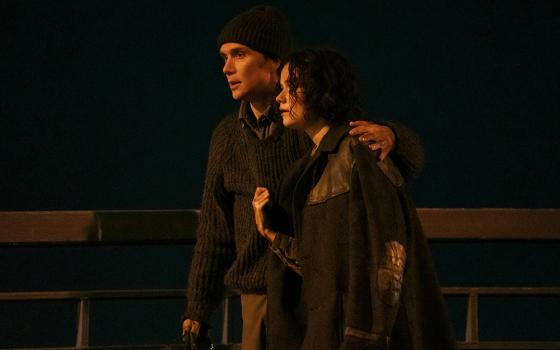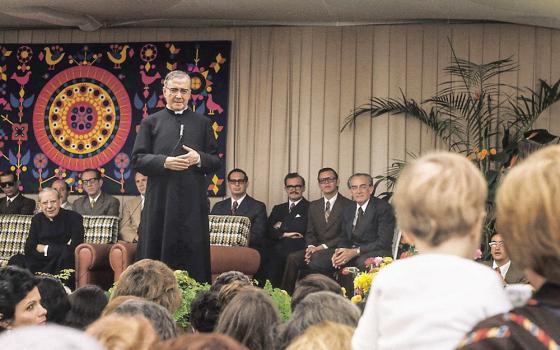
ROME
When popes are in the public eye, it’s usually for lavish Vatican liturgies or some high-profile matter of geopolitics. This morning, however, brought rare images of Benedict XVI as a simple pastor, delivering one-on-one consolation to victims of an April 6 earthquake in the northern Italian region of Abruzzo, which left almost 300 people dead and tens of thousands living in makeshift tent cities.
Benedict XVI spent a little over three hours visiting Onna, a small town almost completely wiped out by the magnitude 6.3 quake, and L’Aquila, where the city’s famous medieval Basilica of Collemaggio was badly damaged.
The pontiff began his visit in a large tent city, at one point embracing a husband and wife who lost all their children, as well as a local journalist who lost both his father and two children. Though the pope delivered two brief speeches, most of his time was devoted to personal conversation with victims, relief workers, and local clergy.
“If it were possible, I would have liked to go to every town and every neighborhood, to go into all the tent cities and to meet everyone,” the pope said.
Benedict occasionally lightened the tone with a couple of uncharacteristically whimsical gestures, such as briefly donning a firefighter’s massive white helmet. For the most part, however, the mood was somber.
“The entire church is here with me, standing with you in your suffering,” the pope told the victims, adding that The Lord “is not deaf to the anguished cry of so many families who have lost everything.”
Benedict attempted to find spiritual meaning in the devastation.
“The pope is here with you today to say a word of comfort about those you have lost: They now live in God, and they’re expecting an example from you of courage and hope. They’re waiting to see this land reborn,” he said.
Saying that the earthquake had no power to destroy God’s love, Benedict said, “Love endures beyond our precarious human existence ... Whoever loves is victorious over death, and knows that those whom they have loved are never lost.”
Yet Benedict did not restrict himself to pieties, also calling for “effective solutions, as soon as possible, for those who are living in tents. I hope for that from the bottom of my heart, and I pray for it,” he said, drawing sustained applause.
The pope also applauded locals for their response.
“I’ve admired your courage, your dignity, and the faith with which you’ve faced this difficult test.” Later, Benedict said that “signs of solidarity” had reached him from all over the world, including “senior personalities from Orthodox churches” who sent not only their prayers but also economic assistance.
Throughout the morning, efforts to allow victims to get close to the pope were clear. For example, in a gesture that hearkened back to an earlier era, Benedict was driven through a piazza in L’Aquila riding in the back of an open-air jeep. That’s how the late John Paul II used to greet pilgrims in St. Peter’s Square, before the 1981 assassination attempt led to the development of the “Popemobile” with its bullet-proof glass.
Benedict’s arrival was delayed by an hour because of strong rain, which prevented him from taking a helicopter to the disaster zone. Instead, he travelled the roughly 25 miles by car. The temperature in Abruzzo hovered just above freezing, a reminder of the cold weather that has complicated relief efforts and made the situation of survivors even more precarious.
Stefano Cristiano, one of hundreds of volunteer relief workers in the area, expressed a concrete hope in that regard: “We’ve been here for ten days, and it’s done nothing but rain. We hope the pope can make it stop raining.”
Benedict called solidarity with suffering people “a measure of a society’s maturity,” comparing it to a “fire beneath the ashes” that erupts in moments of need.
In L’Aquila, Benedict XVI also visited the Basilica of Collemaggio, stopping in the entryway because the interior of the medieval structure has not been declared safe. The pope venerated the remains of St. Celestine V, a 13th century pope whose remains are preserved in the basilica. As an expression of solidarity, Benedict left behind the pallium, or cloth stole, which was placed on his shoulders when he was elected to the papacy four years ago.
Benedict said that visiting the basilica allowed him to “touch by hand the wounded heart of this city.”
Also in L’Aquila, Benedict XVI placed a golden rose before a statue of the Madonna di Roio, a renowned local image of the Virgin Mary. Like the pallium, the golden rose is a deeply traditional symbol: Over the centuries, popes have bestowed them upon special churches, as well as upon Catholic monarchs as a token of their loyalty to the faith.
Because of the special relationship between the papacy and Italy, popes have long felt a particular obligation to offer pastoral care following a crisis. The late John Paul II, for example, visited Sicily within 48 hours of a major earthquake in November 1980, and also went to Assisi three months after another major quake in 1997.
This morning, regional officials presented survivors with one long-awaited gift on the occasion of Benedict’s visit: The first list of houses cleared for people to return was presented, allowing several dozen victims to leave their tents and go home.
John L. Allen Jr. is NCR senior correspondent. See a listing of all of Allen's writing for NCR at ncronline.org/users/john-l-allen-jr where you will also find an RSS feed.




